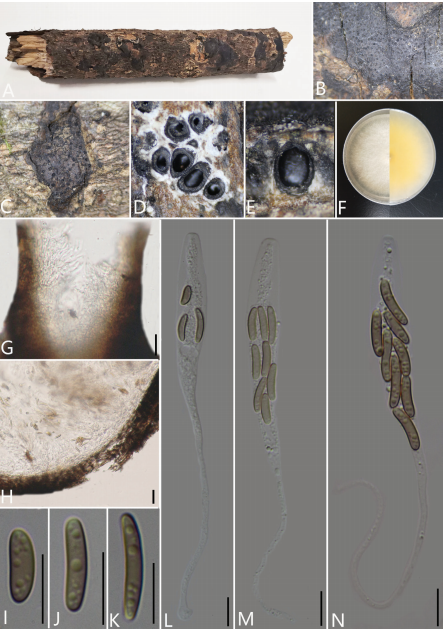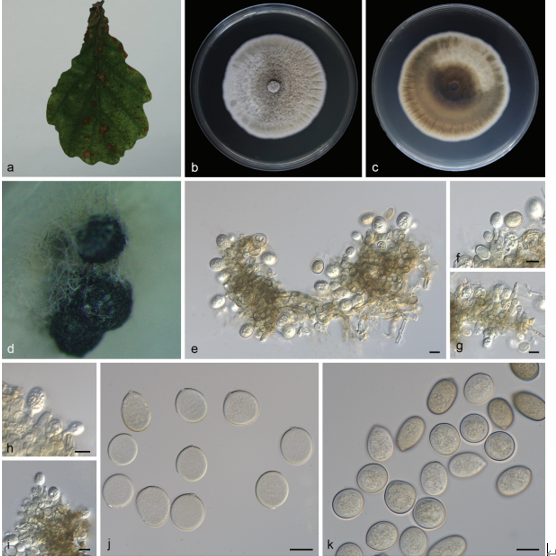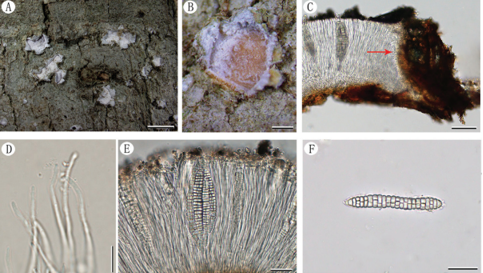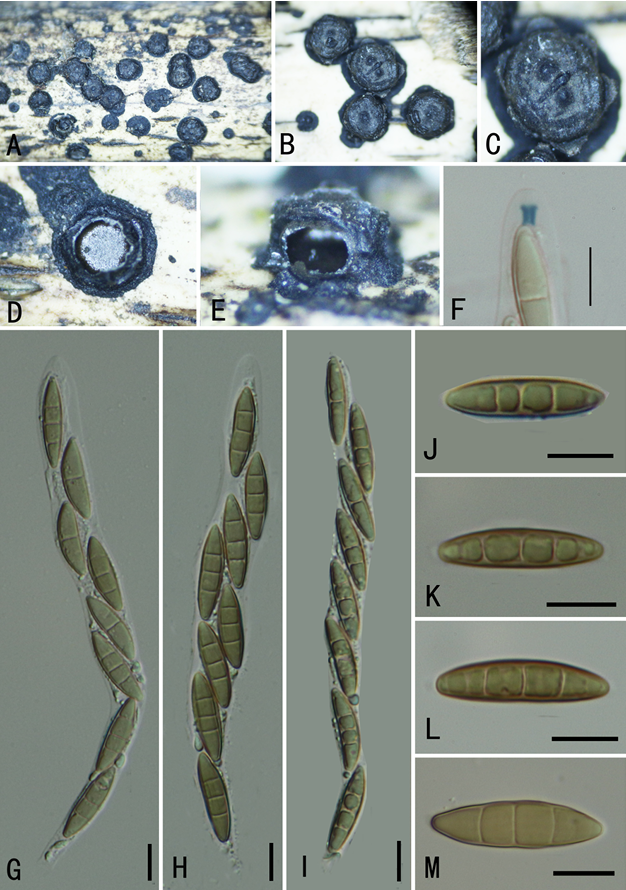Diatrype lancangensis S.H. Long & Q. R. Li, sp. nov 2021
MycoBank No: 839655
Holotype. GMB0045.
Morphological description:
Description. Saprobic on decaying branches of an unidentified plant.
Sexual morph: Stromata immersed in bark, aggregated, irregular in shape, widely effused, flat, margin diffuse, surface dark brown to black, with punctiform ostioles scattered at surface, with tissues soft, white between perithecia. Entostroma dark with embedded perithecia in one layer. Perithecium semi-immersed in stroma, globose to subglobose, glabrous, with cylindrical neck, brevicollous or longicollous 283.5–343.5 μm high,
207–290 μm broad (av. = 315.5 × 248.0 μm, n = 10), ovoid, obovoid to oblong,monostichous,aterrimus.
Ostiole opening separately, papillate or apapillate, central. Peridium 30–50 μm thick, dark brown to hyaline with textura angularis cell layers. Asci 90.5– 160.5 × 7.0–15.0 μm (av. = 129.5 × 10.5 μm n = 30) 8-spored clavate, unitunicate, with rounded apex, apical rings inamyloid. Ascospores 11–18.5 × 2–4 μm (av. = 14.9 ×
2.8 μm, n = 30), irregularly arranged, allantoid, slightly curved, brown to dark brown, smooth, aseptate, usually with oil droplets.
Asexual morph: undetermined.
Culture characteristics. Ascospores germinating on PDA within 24 hours. Colonies on PDA, white when young, became luteous, dense but, thinning towards edge, margin rough, white from above, reverse white at margin, pale yellow to luteous at centre, no pigmentation produced on PDA medium, no conidia observed on PDA or on OA media.
Distribution: China
GenBank: GMB0045 (LSU: MW797057, RPB2: MW81490); GMB00046 (LSU: MW797058); GMB0047 (LSU: MW797060, RPB2: MW814903)
Note. Our new strain, GMBC0045 falls into the unresolved clade (Clade 7) which comprises five Diatrypella and one Diatrype species (Fig. 1), this clade is consistent with the study of Konta et al. (2020). The taxonomic confusion of Diatrypaceae has led to difficulties in separating the genera. We consider that the new species belongs to the genus Diatrype, based on the stromata features mentioned above which closely resemble descriptions of Diatrype subundulata Lar. N. Vassiljeva & Hai X. Ma and Diatrype undulata (Pers.) Fr. (Vasilyeva et al. 2014). However, the ascospores of these species are larger than the ascospores of D. subundulata and D. undulata (Table 2). Phylogenetic analyses also showed that D. lancangensis falls on a separate branch that clustered with species of Diatrypella and Diatrype (Fig. 1). Hence, by combining morphological characteristics and phylogenetic analyses, it seems appropriate to categorise this species as Diatrype.
Preference: Long, S., Liu, L., Pi, Y., Wu, Y., Lin, Y., Zhang, X., Long, Q., Kang, Y., Kang, J., Wijayawardene, N. N., Wang, F., Shen, X., & Li, Q. (2021). New contributions to Diatrypaceae from karst areas in China. MycoKeys, 83, 1–37. https://doi.org/10.3897/mycokeys.83.68926

Diatrype lancangensis (GMB0045, holotype) A stromata on host substrate B, C stromata on
host D transverse sections through ascostroma E vertical section through ascostroma F culture on PDA
G ostiolar canal H peridium I–K ascospores L–N asci. Scale bars: 10 μm (G–N).









